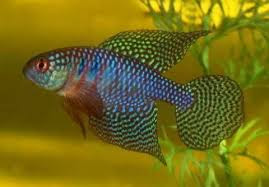Aplocheiloid killifishes, a diversified group of primary freshwater fishes occurring in tropical and subtropical regions of the Americas,
Africa and south-eastern Asia, have been the focus of debates among biogeographers using dispersal and vicariance approaches. The aim of
the present paper is to infer biogeographical events responsible for the present distribution of aplocheiloid killifishes using an event-based
methodology (DIVA) in conjunction to a phylogeny combining mitochondrial DNA sequences and morphology. Optimal ancestral reconstructions
support vicariance events chronologically congruent to northern Gondwana break-up, including separation of Madagascar, India,
South America and Africa plates (about 121 –84 Ma), as well as congruent to paleogeographical events within the Africa plate, such as the
widening of the Benue Trough (about 90–80 Ma) and the start of activity of the East African Rift System (about 30 Ma), and within the
South American plate, as the formation of Gaarland (about 35 –33 Ma), uplift of the Andean Eastern Cordillera (11.8 Ma) and the interruption
of the paleo-Amazonas river basin by the uplift of the Vaupés Swell (about 11 – 7 Ma). The reconstructions also support geodispersal
events related to the colonization of the Greater Antilles (about 35–33 Ma) and Central America areas (3.7–3.4 Ma) by aplocheiloids
through land connections, besides some dispersal events through the Zaire, East Africa, Amazon and Eastern Brazil areas.
The killifish suborder Aplocheiloidei comprises a diversified
clade of small teleosts, usually about 25–50 mm
of total length as maximum adult size, with over 620
species occurring in shallow freshwater or rarely brackish
environments. Aplocheiloids are mostly known by
many included species being popular aquarium fishes,
but some of them are also often used as experimental
animals in laboratories (e.g., Harrington & Kallman,
1968; Wourms, 1972; Park & Kim, 1984). However, the
suggestive geographical distribution of the three families
contained in the suborder, with Aplocheilidae endemic
to Madagascar, Seychelles, and south-eastern Asia,
Nothobranchiidae endemic to sub-Saharan Africa, and
Rivulidae endemic to Middle and South America (Costa,
2004),
has brought the Aplocheiloidei to the focus of debates
involving conflicting explanations about patterns
of historical biogeography in the tropics (Lundberg,
1993; Murphy & Collier, 1997; Briggs, 2003; Sparks
& Smith, 2005).
Biogeographical relationships among aplocheiloid
lineages were first discussed just after Myers (1931) formally
recognising the killifish group presently known as
the suborder Aplocheiloidei. Myers (1938), when noticing
the possible closely relationships among some South
American and African aplocheiloid taxa, claimed that
trans-continental distribution of aplocheiloids could not
be viewed as evidence of an ancient connection between
South America and Africa, since those fish lineages.












0 comments:
Post a Comment